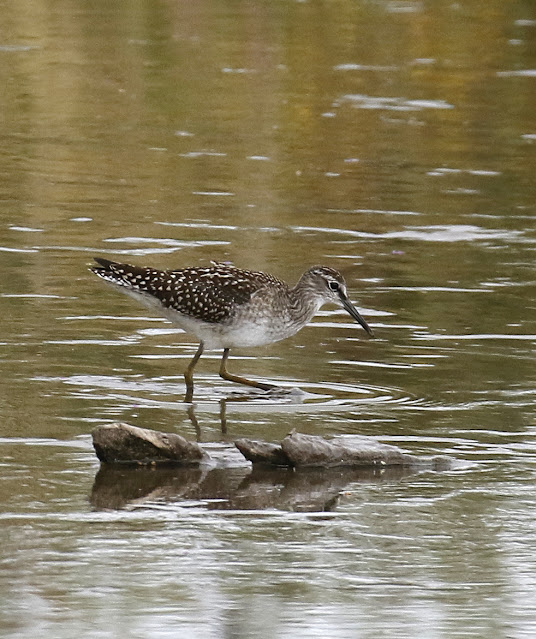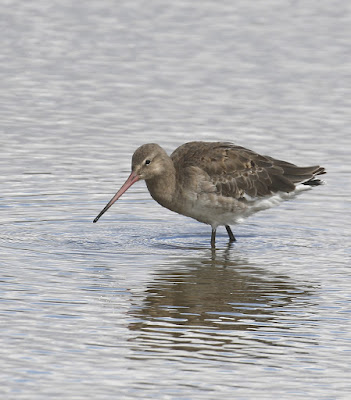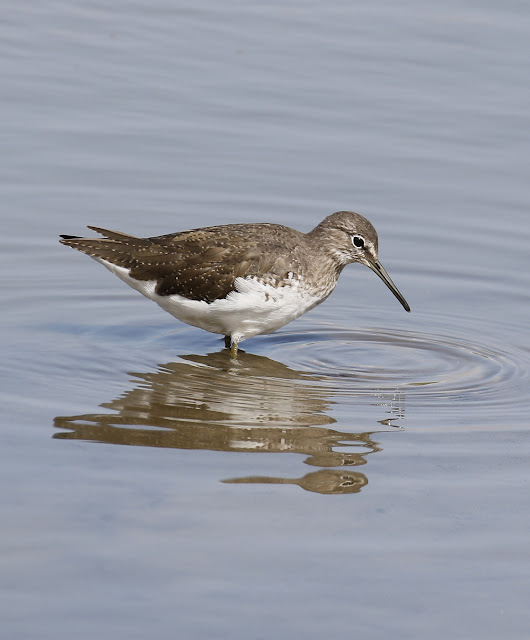This Sunday seemed an opportune time to go and try my luck. It is only an hour's drive across the North Cotswolds and two junctions down the M5 Motorway to Slimbridge, so I left my home at seven in the morning to arrive at Slimbridge an hour later. For no reason I can fathom, Slimbridge does not open its doors to birders or the general public until the comparatively late hour of nine thirty and not a minute before, but if you are a member of the WWT, which I am, you are allowed in by a back gate from eight fifteen onwards, to use the hides sited along an area called The Holden Walkway but not into the rest of the grounds until the hallowed time of nine thirty.
This was not a problem as the Wood Sandpiper was being seen from two hides, the Robbie Garnet Hide and the Stephen Kirk Hide which lie in close proximity to each other along the Holden Walkway and overlook a lagoon of open, shallow water called The Tack Piece.
I wandered down the walkway and entered the Stephen Kirk Hide and looked out to where the sandpiper had been reported as 'showing well' yesterday afternoon. The result was, I suppose, inevitable and highly predictable.There was not a sign of the sandpiper, just two Avocets feeding in the shallow water and a host of extremely noisy Greylag Geese. Distantly, up a broad channel to my right, five Black tailed Godwits and a smaller wader were feeding but it was not possible to identify the smaller wader with my binoculars as it was just too far away. I sat and tried to be philosophical about my circumstances. I was not too downcast as the Wood Sandpiper had been reported from here on most days so it was likely it would turn up eventually. I did have all day after all but how long did I want to sit here?
Something flushed the godwits and the smaller wader and they all flew towards the water in front of the Hide. My totally unrealistic hopes that the small wader might, by some miracle, be the Wood Sandpiper were put to rest as it settled unsteadily on the mud in front of the Hide. It was a Common Redshank and it had an injured leg, causing it to use its spread wings to balance and thus show the diagnostic broad white wing bars as it fluttered on the wet mud.
Being Slimbridge, it was hardly as if there were not other things to go and see, and I reasoned that this might be the best plan and I could return to the Hide later to try again for the Wood Sandpiper. I resolved to walk to the other end of the grounds and to another Hide, the Hogarth Hide, in front of which, I was informed, four Common Cranes were in residence, two adults plus their two almost fully grown young. Being so early in the day, the grounds were virtually deserted and as I made my way to the Hide, inevitably I was distracted by some of the less natural residents of Slimbridge WWT.
Flamingos chiefly, of which Slimbridge has six species, from differing areas of the world
Flamingos chiefly, of which Slimbridge has six species, from differing areas of the world
 |
| American Flamingo |
 |
| American Flamingos |
 |
| Greater Flamingo |
 |
| Young Chilean Flamingos |
 |
| Adult Andean Flamingos |
Two Common Snipe and a Ruff were prospecting the muddy shore where it met the water of South Lake and a couple of Black tailed Godwits flew in, landing in a splash of orange plumaged bodies and black and white wing bars and tail. They were soon on their way again, long legs extended beyond their tails and long bills pointing forward. The Common Cranes were hunkered down in the grass, all four close together, the two juveniles distinctive with their gingery brown heads. Their male parent constantly elevated his neck and head above the vegetation to check on the surroundings. Ever alert and watchful his white neck and charcoal grey head would rise every thirty or so seconds above the swaying grass to check all was well, the square of crimson feathering on his crown obvious even in the dull light.
I sat here for forty five minutes hoping and waiting for the cranes to move but they remained where they were and I grew restless, wondering if maybe the Wood Sandpiper had by now returned to its favoured Tack Piece. I made the long walk back to virtually the other end of the grounds and when I got to the Holden Walkway I decided to try the Rushy Hide which lies just before the other two Hides, mentioned earlier and looks out onto another area of shallow water adjacent to the Rushy Pen. This Hide has no seats and so you just stand and look out of the viewing slats. I entered the Hide and was astounded to find it full, well almost, there was one space left at the far end of the small Hide which I promptly occupied. Something was obviously interesting everyone, expert and amateur alike, as cameras and optics were all pointing to a nearby muddy corner of the shallow lagoon, interspersed with scattered scrapes.
 |
| The view of the lagoon from the Rushy Hide |
 |
| The corner of the lagoon to the right of the Hide that was favoured by the Wood and Green Sandpipers |
 |
| Wood Sandpiper |
The Wood Sandpiper was liberally spotted and chequered with white on fundamentally mid brown upperparts, its head showed a prominent white supercilium and it sported a finely streaked beast band diffusing into pure white underparts. Its legs were pale yellow rather than the greener legs of the Green Sandpipers.
All of us with cameras clicked away as the Wood Sandpiper fed energetically along the margin of the lagoon or waded deeper into the water, mud clinging to its feet and legs as it withdrew them from the water. It wandered back and fore, mingling with the Green Sandpipers, never still and constantly active, changing direction frequently to pick at invisible items on the water's surface. For half an hour it remained faithful to this secluded corner of the lagoon, fortuitously right at my end of the Hide.
Then something caused an alarm amongst the Green Sandpipers and with a melodic, loud whistling tooo wheet wheet call the Green Sandpipers took off, as did the Wood Sandpiper, and they all flew right down to the far end of the lagoon and out of sight. The dark upperpart plumage of the Green Sandpipers contrasting strikingly with their pure white rumps, bringing to mind an image of a giant House Martin
The Hide rapidly cleared after the Wood Sandpiper's departure as everyone recognised the show was now over. I remained, partly because I hoped the Wood Sandpiper might return but also because there were other waders to admire and there would undoubtedly be some really good photo opportunities. In the end I resolved to spend the rest of the day here as it was very enjoyable to watch and photograph the comings and goings of the birds and their activities. If the Wood Sandpiper did return that would be the icing on the cake.
Undoubtedly the main attraction after the Wood Sandpiper departed were the Green Sandpipers that soon returned and were never absent from the lagoon throughout. At least seven were scattered around the lagoon and some came very close indeed, right in front of the Hide in some cases. Being shorter legged than the Wood Sandpiper, they are a less elegant in movement, more hunched in stature and their plumage is much darker. The upperparts, including the head, are dark brown with a very slight greenish gloss in a good light and their eye is surrounded by a white ring but their head lacks the prominent supercilium of the Wood Sandpiper. The breast band is also dark and prominent, sharply demarcated from the rest of the pure white underparts.When they take off the white rump, as mentioned, is in stark contrast to the dark upperparts.
 |
| Green Sandpiper |
There was much else to see apart from the Green and Wood Sandpipers.
Here are some of the highlights during an enjoyable day long vigil in the Rushy Hide and which became even more pleasurable as the predicted sunny spells arrived on schedule just after noon
Black tailed Godwits
Ten or more Black tailed Godwits were stood on a nearby scrape, usually perched on one long leg in the lee of some vegetation to shelter from the still strong wind, their long straight bills tucked cosily into their back feathers. They were dressed in variable plumages, the adults either in a scruffy transition from their breeding plumage of barred, brick orange underparts and chequered brown and black upperparts to the more uniform brownish grey of winter plumage, or they already had completed the moult into winter garb, whilst a couple of juveniles looked immaculate in their unmarked, entirely orange underparts and upperparts of dark brown, scalloped with orange fringes, not a new feather out of place.
 |
| Juvenile Black tailed Godwit |
Initially they slept, reluctantly moving when disturbed by another bird but then, retracting one leg into their belly feathers and snuggling their bill into their back feathers, they resumed their dozing on a now warm and sunny day.
 |
| Adult Black tailed Godwits moulting from their breeding plumage into winter plumage. The individual in front is much more advanced with its moult than the one behind |
When thoroughly soaked it just sat in the water as if exhausted or maybe savouring the coolness of the water and maybe the fact it stopped its moulting feathers itching, then waded out to preen its bedraggled feathers and adjust its plumage, a process that was both lengthy and thorough and of which it never seemed quite satisfied.
 |
| Black tailed Godwit in its winter plumage |
 |
| Black tailed Godwit still in almost full breeding plumage |
Green Sandpipers
Seven at least graced the lagoon, most feeding at the end nearest to the Hide and coming very close at times. Their compact forms endlessly moving through the water and mud, their white underparts shining against the dark water as they waded through it.
On flying, an individual bird would call an excited melodic tooo wheet wheet that rang through the air as it flew off at high speed, an indistinct blur of black and white, even the underwings were dark so the white areas of plumage became almost disembodied as the bird disappeared into the distance.
Their dark upperpart plumage could be seen to be spotted with white or buff when seen close to but it was not nearly as distinctive as on the Wood Sandpiper.They were also more confiding than the Wood Sandpiper, feeding along the edge of the lagoon, passing right under and along the shore in front of the Hide. One bird on seeing the Black tailed Godwit bathing was stimulated to do the same and literally threw itself about exuberantly on the water right by the godwit before floating in the water presumably enjoying the sensation. It floated there for a couple of minutes before vigorously bathing, flapping its wings energetically and throwing itself around in the water to get itself thoroughly wet and then stood on the shore to preen and put its plumage in order before resuming feeding.
Another, in the late afternoon sunshine squatted on the dry mud, its belly flat to the surface, drooped its wings to its sides and sunbathed, the very picture of late summer indolence and contentment. In a bird's life this state of relaxation must be such a rare indulgence.
 |
| Note the dark brown underwings and barred axillaries |
Ruff
Along with Rook and Smew they have the shortest name for any British bird and which was first used in 1654. They get their name from the remarkable plumes that grow around their head forming into an extravagant collar or ruff of many different colours and patterns on each individual male and which they adopt in the breeding season. The males then assemble at a lek to perform their demented displays and mate with the smaller, dull coloured females that are called reeves. Previously they bred in large numbers in eastern England but were over exploited as a food source and combined with the reclamation of wetlands the consequence was they became extinct as a breeding bird in England by 1850. One hundred years later they returned and began to lek at a few sites in East Anglia and this year Frampton RSPB in Lincolnshire was a well known site to which to go and observe Ruffs lekking but this is now a rare event and will remain so as they will never be able to regain the overall numbers that were present in England all those years ago.
 |
| Adult male Ruff |
 |
| Juvenile male Ruff |
Lapwings
One or two wandered the grassy areas around the lagoon and one bird got caught up in the current frenzy to bathe in the lagoon's shallow water. As with the Green Sandpiper and Black tailed Godwit it undertook this task with some vigour and application and like them sat for a time motionless in the water, floating somewhat dishevelled, up to its neck, in the water. They are familiar birds, thousands migrating here from the East to spend the winter in our milder climate, when they can be seen whirling in a flock that alternates black and white above fallow or grass fields that often form their winter home. Others are resident and breed in whatever suitable habitat is still available for them.Their superficially black and white plumage is in fact something more, the upperparts shot like silk with subtle shades of colour.They are not black at all on their upperparts but bottle green infused with purple and blue iridescence. Their head adorned with a whispy black crest.
 |
| Lapwing bathing |
Common Snipe
Invisible at first, they betrayed their presence when they were disturbed from their secret hiding places in the sparse vegetation on some of the scrapes, flying a short distance to land and immediately crouch, before sidling into cover. Their plumage is a basic camouflage of brown, black and buff but of extraordinary complexity which assists them to meld into invisibility in their favoured habitat of dead reeds and grass. Today, in the afternoon, they became emboldened and emerged to feed furtively along the edge of the scrapes, never straying far from cover. They mainly eschewed wading in the water and inserting their preposterously long bills into the submerged mud but instead nibbled at the moss and weed at the water's edge, using the sensitive tips of their mandibles with some delicacy and finesse. Its bill is proportionately the longest of any British bird and seems outlandish when seen from any angle.
Garganey
This duck is unique in that it is the only duck that migrates to visit our shores in summer rather than coming to spend the winter, leaving again in the autumn to spend its winter in southern Africa. A male was asleep on a small muddy scrape with a few Eurasian Teal for company. All are currently in their eclipse plumage of dull browns as they await the re-growth of their spectacular and colourful breeding plumage. The Garganey could be distinguished by its slightly bulkier and larger build with a distinctive profile caused by the longer bill. I could tell it was a male and a Garganey as it lazily stretched out each wing to expose the pale grey areas on its forewings.Their head pattern is more complex than a teal with a pale supercilium above a dark eye stripe and another smaller dark stripe on each of its cheeks. It sat for a long time, content in the sun before taking to the water to feed with some teal, its head mostly under the water as its sifted through the muddy waters.
 |
| Male Garganey. Note the pale grey forewing and broad white fringes to the speculum |
 |
| Eurasian Teal. Note the darker grey forewing and different pattern and colour to the speculum |
 |
| Black tailed Godwit and Green Sandpiper bathing |
 |
| Amorous Woodpigeons |
 |
| Male Common Linnet |
 |
| European Goldfinch |
 |
| Grey Wagtail |
 |
| Juvenile Little Ringed Plover |
 |
| Avocet |
 |
| Juvenile Marsh Harrier |
 |
 |
| Common Cranes |
Please click on any image to view a larger version





































































No comments:
Post a Comment